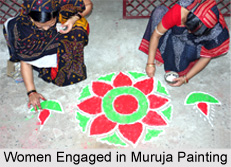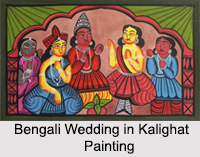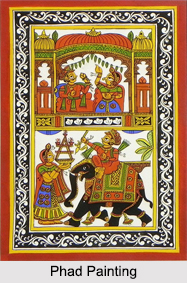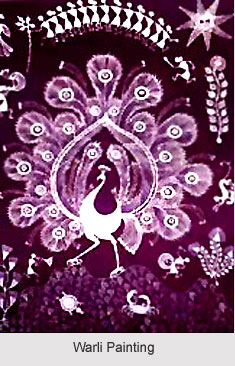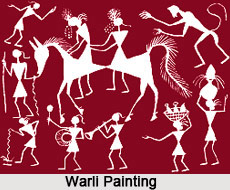 Warli painting is a very popular form of tribal painting in India. Their major themes include the harvest season, celebration, wedding, rituals and births.
Warli painting is a very popular form of tribal painting in India. Their major themes include the harvest season, celebration, wedding, rituals and births.
Origin of Warli Painting
Warli is the name of the largest tribe found at the outskirts of Mumbai, Maharashtra. The term `warli` has its etymological roots in `warla` meaning a piece of land or field. There is a belief among the historians that the tradition of Warli dates back to the Age between 2,500 BC and 3,000 BC. This has since moved across the territories and borders and has now become a precious possession of several art lovers and collectors. The Warlis are mainly a tribe dependant on agriculture and they live in thatched mud-huts, which are built is such a way that they all encircle a central cell. The houses of Warlis are decorated with a vocabulary of patterns. This practice encouraged to what it is presently called the Warli Paintings. Warli paintings largely demonstrate the basic components of life which are the primary themes or basis of any tribe. Warli art holds a special characteristic of exhibiting the humble life led by the Warli tribe.
Style of Warli Paintings
Warli Paintings are characterised by the simplistic style which is employed to convey the profoundest things. Colours used in the Warli paintings are limited to stark white opposite to earthen backgrounds. Most of the paintings dominated by geometrical designs, and crooked lines and dots form the units of these compositions are monochromatic tribal paintings which express different types of folk imaginations, customs and beliefs. The moods and whims of the life led by the tribes form interesting themes for the Warli Paintings. They are more than mere designs on walls, and form the authentic presentation of a way of life. However, the philosophy of a way of life, especially those of tribal societies, is best depicted through colourful images.
Themes of Warli Paintings
The indolent mundane village life interrupted only by the sound of birds and cold nights with bonfires and merry making women and men, the splash of streams which flow by Warli hamlets, and the playing of a native instrument by a shepherd form the rhythm of the Warli life which is captured beautifully in very simple and unpretentious images in white in the Warli paintings.
Symbolism in Warli Paintings
Birds, trees, women and men get together to form a composite whole in the paintings of the tribe and the Warli Paintings among them form the happiest celebration of the concerned philosophy. Even spiral formations of men and women and concentric circular designs in Warli Paintings are symbolic of the circle of life. There are several paintings which look very simple but are symbolic. The balance and harmony presented in these paintings is thought to symbolize the balance and harmony of the universe. Dissimilar to other art forms of tribes, the Warli Paintings do not take the help of religious images, thus, making the paintings more secular in nature.
The most frequent theme of Warli paintings is marriage. Several paintings portray the marriage god called Palghat, attended by a horse and the groom and the bride. They consider these paintings sacred. Men and women dancing in circles, during various celebrations, is another theme typical to the Warli Paintings. Fauna and flora are also presented in these paintings. In recent times, these paintings also include a few modern elements like bicycles or transistors tucked in corners of the paintings.
The cracked village walls of Warli have been decorated with paintings for centuries and still today they act as the most prominent decoration of a majority of such houses. Great epics or mythology are not narrated in the Warli paintings. Warli paintings on paper have now become very famous and have their markets all over India. Today small paintings are done on clothes but it looks best on walls. Painted on mud, surface based on charcoal along with rice paste in order to get the white colour the Warli paintings deal with themes which speak about the social activities and lifestyle of the Warlis. The relaxed rhythmic movement suggested by each of the paintings gives life to it.
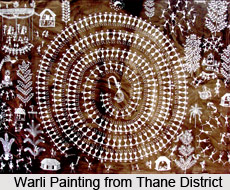 Certain basic Warli Paintings portray some rudimentary graphic vocabulary: a triangle, a circle and a square. The paintings are mainly monosyllabic. The triangles and circle are on the footprints from their observation of nature; the circle represents moon and sun, and triangle derived from trees and mountains. Square obeys different logic. The central idea of each ritual painting is the square which is known as "Chauk" or "chaukat", mostly of two types: Lagnachauk and Devchauk.
Certain basic Warli Paintings portray some rudimentary graphic vocabulary: a triangle, a circle and a square. The paintings are mainly monosyllabic. The triangles and circle are on the footprints from their observation of nature; the circle represents moon and sun, and triangle derived from trees and mountains. Square obeys different logic. The central idea of each ritual painting is the square which is known as "Chauk" or "chaukat", mostly of two types: Lagnachauk and Devchauk.
Male gods take unusual shapes among the Warli paintings and are related to spirits which have taken human shapes. The central design in these ritual paintings is surrounded by scenes portraying fishing, hunting and farming, festivals and dances, trees and animals.
The bodies of humans are mainly represented by two triangles joined at the tip; the upper triangle represents the trunk and the lower triangle the pelvis. Their unstable balance symbolizes the stability of the universe, and of the couple, and has the sensible and humorous advantage of animating the bodies.

